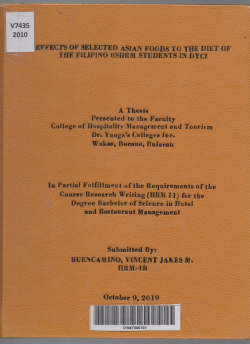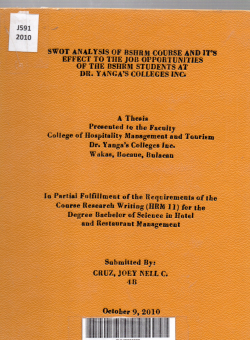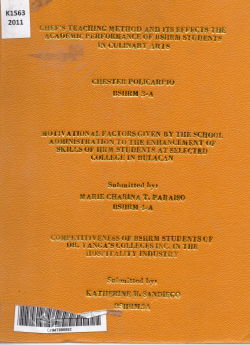Effects of Selected Asian Foods to the Diet of the Filipino BSHRM Students in DYCI

Type
Thesis
Authors
Category
CHMT
[ Browse Items ]
Abstract
Descriptive research refers to the type of research question, design and data analysis that will applied to a given topic. This research can be either quantitative or qualitative. It can be involve collections of quantitative information that can be tabulated along a continuum in numerical form. It involves gathering data that descriptive events and then organizes, tabulates and describes and data collection. And the descriptive function of research is heavily dependent on instrument of measurement and observation.
This study effects of selected asian foods to the diet of the Filipino BSHRM students in dyci is a descriptive research which aimed to answer the major problem:How do the selectedasian foods affect the diet of the Filipino BSHRM students in DYCI.It is also sought answer to the following specific probles; A. what is the profile of the respondents in terms of age , gender and civil status? B. what are the kinds of diet of the BSHRM students? C. what are the ingredients and benefits derived in eating the asian foods? The independent variables are about selected asian foods like china, japan, vietnam, malaysian, singapore, india and Philippines and consist and foods and drinks. The moderating variable are consist of recipes, cooking procedures, nutrient, cost and food preparation. The dependent varible is the effect to the diet of Filipino BSHRM students in bulacan, in terms of illness and benefits.
The researchers formulated the instrument needed to gather the necessary data. The instrument is the edited by an expert adviser and validated upon approval. The researcher wrote a letter to the OIC Dean of College of Hospitality Mnaagement and tourism in Dr. Yangas Colleges, Inc. asking permission and approval to allow his administers the instrument to the college students under his jurisdiction. Upon approval of request, the researcher asked the HRM students to response with his questionnaires on thier availble time.
A total of 100 BSHRM students from Dr. Yangas colleges, Inc. provided the necessary data to complete this research.The data were gathered through a homemade quetionnaire which was formulated by the researcher, checked and approved by the professor and was administered to the respondents.
The gathered data were presented in tabular and texual form, analyzed and interpreted statistically.
Statistical measures such as frequency,mean,mean rating, percentage and rank were used the hypothesis of the study was tested using the chi-square test.
The findings of the study are as follows:
1. The profile of the respondents.
a. more than half of BSHRM students of DYCI is in the age bracket of 918-20)
B. more than half of BSHRM students of DYCI are male.
c. less than 100 BSHRM srtudents of DYCI are single.
2. The kinds of diets of the BSHRM students.
the kinds of diet of the BSHRM students are atkins diet, single food diet, blood type diet, hay diet, zone diet and others.
3. The ingredients and benefits derived in eating the asian food.
Most of the ingredients in eating asian foods are vegetables such as cabbage, lettuce, carrot, beans mushrooms, etc. they also use fresh seafoods like tuna, salmon, lobsters, prawns etc. spices like cinnamon, garlic onions, curry, etc.
Its benefits in eating asian foods are immunity in cancers, less heart attack; it gives long life, giving us energy to work for hte whole day and etc.
Conclusion;
1. May of the BSHRM students use the single food diet.
2. That asian foods being serving to the restaurants have vegetables foods, seafoods, spicy foods and less meat foods.
The data were gathered through a homemade questionnaire which was formulated by the researcher, checked and approved by the professor and was administered to the respondents.
The gathered data were presented in tabular and textual form, analyzed and interpreted statistically.
Statistically measures such as frequency, mean, mean rating, percentage and rank was tested using the chi-square test.
This study effects of selected asian foods to the diet of the Filipino BSHRM students in dyci is a descriptive research which aimed to answer the major problem:How do the selectedasian foods affect the diet of the Filipino BSHRM students in DYCI.It is also sought answer to the following specific probles; A. what is the profile of the respondents in terms of age , gender and civil status? B. what are the kinds of diet of the BSHRM students? C. what are the ingredients and benefits derived in eating the asian foods? The independent variables are about selected asian foods like china, japan, vietnam, malaysian, singapore, india and Philippines and consist and foods and drinks. The moderating variable are consist of recipes, cooking procedures, nutrient, cost and food preparation. The dependent varible is the effect to the diet of Filipino BSHRM students in bulacan, in terms of illness and benefits.
The researchers formulated the instrument needed to gather the necessary data. The instrument is the edited by an expert adviser and validated upon approval. The researcher wrote a letter to the OIC Dean of College of Hospitality Mnaagement and tourism in Dr. Yangas Colleges, Inc. asking permission and approval to allow his administers the instrument to the college students under his jurisdiction. Upon approval of request, the researcher asked the HRM students to response with his questionnaires on thier availble time.
A total of 100 BSHRM students from Dr. Yangas colleges, Inc. provided the necessary data to complete this research.The data were gathered through a homemade quetionnaire which was formulated by the researcher, checked and approved by the professor and was administered to the respondents.
The gathered data were presented in tabular and texual form, analyzed and interpreted statistically.
Statistical measures such as frequency,mean,mean rating, percentage and rank were used the hypothesis of the study was tested using the chi-square test.
The findings of the study are as follows:
1. The profile of the respondents.
a. more than half of BSHRM students of DYCI is in the age bracket of 918-20)
B. more than half of BSHRM students of DYCI are male.
c. less than 100 BSHRM srtudents of DYCI are single.
2. The kinds of diets of the BSHRM students.
the kinds of diet of the BSHRM students are atkins diet, single food diet, blood type diet, hay diet, zone diet and others.
3. The ingredients and benefits derived in eating the asian food.
Most of the ingredients in eating asian foods are vegetables such as cabbage, lettuce, carrot, beans mushrooms, etc. they also use fresh seafoods like tuna, salmon, lobsters, prawns etc. spices like cinnamon, garlic onions, curry, etc.
Its benefits in eating asian foods are immunity in cancers, less heart attack; it gives long life, giving us energy to work for hte whole day and etc.
Conclusion;
1. May of the BSHRM students use the single food diet.
2. That asian foods being serving to the restaurants have vegetables foods, seafoods, spicy foods and less meat foods.
The data were gathered through a homemade questionnaire which was formulated by the researcher, checked and approved by the professor and was administered to the respondents.
The gathered data were presented in tabular and textual form, analyzed and interpreted statistically.
Statistically measures such as frequency, mean, mean rating, percentage and rank was tested using the chi-square test.
Number of Copies
1
| Library | Accession No | Call No | Copy No | Edition | Location | Availability |
|---|---|---|---|---|---|---|
| Main | 6141565 | V7435 2010 | 1 | Yes |




